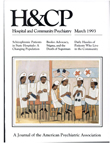Quality of Care and Outcomes of Chronic Mentally Ill Patients in Hospitals and Nursing Homes
Abstract
Quality of care in three types of facilities in which chronic mentally ill patients reside was examined to determine how it was related to patient functioning and to determine bow patients' dependency on others for self-care moderated relationships between quality of care and patient functioning. Methods: Discriminant function analyses and multiple regression analyses were used to examine 12-month follow-up data from a Department of Veterans Affairs (VA) study of 294 chronic mentally ill patients in 52 community nursing homes, nine VA nursing home care units, and 43 VA hospital psychiatric units. Results: The three types of facilities were best differentiated by staff and resident characteristics and facility policies. Residents of community nursing homes were more impaired, and staff were less well trained, than in the VA facilities. The community nursing homes had less restrictive policies. Patients who lived in facilities that gave them more control over their daily lives and that bad larger proportions of high-functioning patients reported more life satisfaction and vigor. Patients in facilities with more social and recreational activities reported less life satisfaction. The extent to which facility features were beneficial or harmful was related to patients' self-care dependency. Supportive physical features and living-assistance services tended to aid impaired residents, whereas more experienced staff and policies that promoted control by residents tended to aid independent residents. Conclusions: Program managers may need to tailor facility environments to patients' level of functioning to maximize beneficial effects.
Access content
To read the fulltext, please use one of the options below to sign in or purchase access.- Personal login
- Institutional Login
- Sign in via OpenAthens
- Register for access
-
Please login/register if you wish to pair your device and check access availability.
Not a subscriber?
PsychiatryOnline subscription options offer access to the DSM-5 library, books, journals, CME, and patient resources. This all-in-one virtual library provides psychiatrists and mental health professionals with key resources for diagnosis, treatment, research, and professional development.
Need more help? PsychiatryOnline Customer Service may be reached by emailing [email protected] or by calling 800-368-5777 (in the U.S.) or 703-907-7322 (outside the U.S.).



